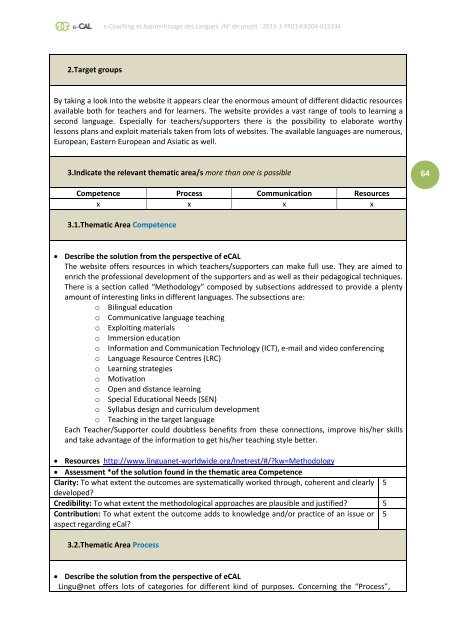e-CAL - e-Coaching et Apprentissage des Langues
The ERASMUS+ project e-CAL presents the result of an analysis of support methods in the case of language learning using web-based Open Educational Resources (OER).
The ERASMUS+ project e-CAL presents the result of an analysis of support methods in the case of language learning using web-based Open Educational Resources (OER).
You also want an ePaper? Increase the reach of your titles
YUMPU automatically turns print PDFs into web optimized ePapers that Google loves.
e-<strong>Coaching</strong> <strong>et</strong> <strong>Apprentissage</strong> <strong>des</strong> <strong>Langues</strong> /N° de proj<strong>et</strong> : 2015-1-FR01-KA204-015334<br />
2.Targ<strong>et</strong> groups<br />
By taking a look into the website it appears clear the enormous amount of different didactic resources<br />
available both for teachers and for learners. The website provi<strong>des</strong> a vast range of tools to learning a<br />
second language. Especially for teachers/supporters there is the possibility to elaborate worthy<br />
lessons plans and exploit materials taken from lots of websites. The available languages are numerous,<br />
European, Eastern European and Asiatic as well.<br />
3.Indicate the relevant thematic area/s more than one is possible<br />
64<br />
Comp<strong>et</strong>ence Process Communication Resources<br />
x x x x<br />
3.1.Thematic Area Comp<strong>et</strong>ence<br />
Describe the solution from the perspective of e<strong>CAL</strong><br />
The website offers resources in which teachers/supporters can make full use. They are aimed to<br />
enrich the professional development of the supporters and as well as their pedagogical techniques.<br />
There is a section called “M<strong>et</strong>hodology” composed by subsections addressed to provide a plenty<br />
amount of interesting links in different languages. The subsections are:<br />
o Bilingual education<br />
o Communicative language teaching<br />
o Exploiting materials<br />
o Immersion education<br />
o Information and Communication Technology (ICT), e-mail and video conferencing<br />
o Language Resource Centres (LRC)<br />
o Learning strategies<br />
o Motivation<br />
o Open and distance learning<br />
o Special Educational Needs (SEN)<br />
o Syllabus <strong>des</strong>ign and curriculum development<br />
o Teaching in the targ<strong>et</strong> language<br />
Each Teacher/Supporter could doubtless benefits from these connections, improve his/her skills<br />
and take advantage of the information to g<strong>et</strong> his/her teaching style b<strong>et</strong>ter.<br />
Resources http://www.linguan<strong>et</strong>-worldwide.org/ln<strong>et</strong>rest/#/?kw=M<strong>et</strong>hodology<br />
Assessment *of the solution found in the thematic area Comp<strong>et</strong>ence<br />
Clarity: To what extent the outcomes are systematically worked through, coherent and clearly 5<br />
developed?<br />
Credibility: To what extent the m<strong>et</strong>hodological approaches are plausible and justified? 5<br />
Contribution: To what extent the outcome adds to knowledge and/or practice of an issue or 5<br />
aspect regarding eCal?<br />
3.2.Thematic Area Process<br />
Describe the solution from the perspective of e<strong>CAL</strong><br />
Lingu@n<strong>et</strong> offers lots of categories for different kind of purposes. Concerning the “Process”,


